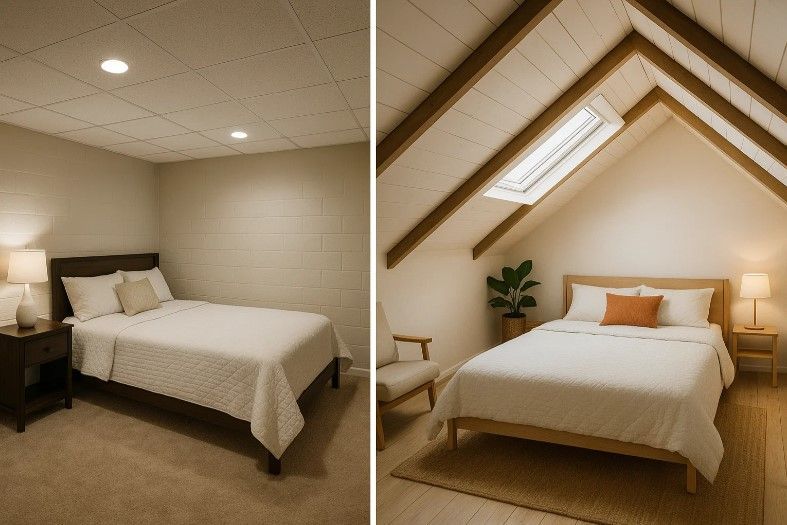Abbotsford Home Renovations
Converting Basements and Attics into Extra Bedrooms
According to the Canadian Mortgage and Housing Corporation (CMHC), searching for and spending on 'home renovation services near me' in Canada grew by 10%.
Some homeowners are thinking of a basement conversion, which is an efficient solution to maximize the space within their home.
As housing prices continue to rise, converting underused spaces into livable areas is a practical approach to expand without needing costly new build or full renovation.
But the question here is, how will this renovation work? Let's find out.
Key Takeaways
- Converting basements and attics into bedrooms is a good way to increase usable space and home value without a full renovation.
- Meeting building code requirements for egress, ceiling height, ventilation, and insulation is essential for safe and comfortable living spaces.
- Thoughtful design elements like lighting, colour schemes, smart storage, and multipurpose furniture can turn underused areas into functional rooms.
Your Conversion Must be Safe, Legal, and Comfortable
Egress
Windows must have an unobstructed opening of at least 0.35 square meters with a minimum dimension of 380 mm. For basements, this requires enlarging window wells or adding new openings, while attics may need dormer additions.
Ceiling Height
The BCBC mandates a minimum ceiling height of 2.1 meters for bedrooms.
- In basements, this may involve lowering the floor or raising the foundation.
- In attics, structural reinforcements, such as adding support beams, may be needed to accommodate ceiling height without compromising the roof structure.
Insulation and Moisture Control
The National Building Code of Canada recommends R20 to R22 insulation for basement exterior walls. Moisture barriers and sump pump systems are necessary in areas with high water tables, while attics require adequate ventilation to prevent condensation buildup.
How to Start Renovating the Rooms
Retrofitting a Staircase to Your Attic Room
- For safe passage, the minimum width for a staircase is 36 inches. In narrower homes, you can reduce the width to 30 inches, but this must be verified with local building authorities.
- The maximum riser height (vertical part) should not exceed 7 3/4 inches, and the tread depth (horizontal part) must be at least 10 inches.
- The staircase must maintain at least 6 feet 8 inches of headroom clearance.
Using Lighter Colours to Open Up the Space
For a custom home renovation, it's advisable to consult interior designers. When converting a room or even doing bathroom remodelling, opt for lighter shades on walls, ceilings, and floors to ease the feeling of confinement.
For example:
| White or Off-White Shades | On the ceiling, it attracts the eye upward to make the ceiling look raised |
| Neutral Tones (like light gray or beige) | On walls, it can add warmth without overwhelming the space. |
Avoid dark tones on the ceiling in basements with lower ceilings, as this can compress the room visually.
LRV (Light Reflectance Value) measures how much light a colour reflects; lighter shades have higher LRVs, which means they reflect more light into the room.
- For basements with lower ceilings (under 8 feet), using a colour with an LRV above 80 helps create the illusion of more height.
- Painting the walls a shade lighter than the floor but not as light as the ceiling can create depth without compressing the room’s vertical lines.
Optimizing Lighting Features
Your home renovation contractor will let you choose the lighting fixture to install in the room. Here are your options:
Ambient Lighting
Installing 6-inch LED recessed lights in basements and attics with a colour temperature of 3000 K- 3500 K (soft white) will create an inviting atmosphere while ensuring adequate brightness. For major renovations, the recommended spacing for recessed lights in a basement or attic with an 8-foot ceiling is approximately 5 feet apart.
Task Lighting
This is good for reading, working, or grooming. Adjustable floor or desk lamps with LED bulbs (5000 K- 6000 K for cooler light) are ideal for focused work. In closets or under shelving, under-cabinet LED strips provide task lighting without taking up space.
Accent Lighting
- Wall sconces, pendant lights, or LED strip lighting behind furniture can enhance the room’s aesthetic without overwhelming the eye.
- Cove lighting in attic rooms can add warmth and height by illuminating the upper edges of walls or ceilings.
This also applies if you opt for a kitchen renovation or any home repair project for your dream home.
Great work. Fair pricing. Happy customers across the Lower Mainland. Let Abbotsford Home Renovations handle your next project.

Opting for Multipurpose Furniture
- A queen-size bed frame with drawers can provide up to 13 cubic feet of storage. This reduces the need for a separate dresser to free up floor space for other uses.
- A 30" x 40" fold-out desk can be mounted to the wall and stowed away when not in use. This type of desk minimizes clutter and maximizes floor space.
- You can conceal a Murphy bed within the wall to free up the room during the day. Depending on the bed size, it requires a minimal ceiling height of 7 feet and a clear wall space of at least 60-70 inches wide.
Using Vertical Elements
- Installing built-in shelving units measuring 12-15 inches deep is ideal for storing books, decor, and personal items. This also applies to a bathroom renovation project.
- In areas with limited floor space, opt for tall storage units, such as wardrobes at least 72 inches in height, to maximize the vertical zone.
- For attics with sloped ceilings, wall-mounted shelves can be customized to fit the lower sections of the walls.
Considering Mirror Placement
Placing a mirror across from a window (or skylight, in attics) allows natural light to bounce throughout the room.
| Large mirror (at least 48 inches in height) | Can give the illusion of a larger zone when placed in a small room. |
| Full-length mirrors or mirror panel | Expand the bedroom's visual expanse and storage when installed on closet doors. |
Defining Zones for Different Activities
- Use area rugs to define different zones. For example, a 5' x 8' rug can separate a seating area from a sleeping area in a basement or attic bedroom.
- Sliding glass partitions or open shelving units can separate distinct areas (like a home office from a bedroom) without obstructing light flow or making the room feel closed off. These dividers should be at least 72 inches tall to create a substantial division without overwhelming the expanse.
Another effective strategy is to arrange furniture to create specific zones. For example, a desk in front of a window can designate a work area, while a couch in front of a TV can define a relaxation zone.
Adding Architectural Interest
Attic conversions showcase exposed beams, which add structural integrity and aesthetic appeal. However, to prevent moisture damage, the contractors must finish the beams properly.
- Adding trim, baseboards, or crown moulding is highly recommended to elevate the space's appeal.
- For low-ceiling basements, a thin crown moulding around the perimeter can create a cleaner, more polished look without making the room feel shorter.
Incorporating Smart Storage Solutions
In basements, the coverage under staircases can be optimized with pull-out drawers or hidden cabinets, providing up to 20 cubic feet of added storage.
- Cabinets with doors measuring 16-20 inches in height can be custom-fitted to maximize storage without sacrificing floor coverage.
- Install wall-mounted cabinets at least 10 inches deep for storing household items like linens, cleaning supplies, or seasonal clothing, keeping the room clutter-free.
Design Inspirations for New Home Feature
Consider Using Wood Materials
Opt for wood floors, stone fireplaces (if applicable), and furniture with natural finishes.
- Choose reclaimed wood for flooring that is sustainable and consistent with the theme.
- Hardwood floors can be treated with a matte finish to reduce gloss and preserve the natural look of the wood grain.
- Incorporating metal hardware, like iron bed frames or bronze light fixtures.
- For lighting, choose fixtures with industrial-style designs to balance the warmth of the wood with a bit of edge.
Make it Like a Camp
- Using bunk beds or loft beds elevates the sleeping area to leave room for storage or a desk underneath. Make sure you have at least 36 inches of leeway between the top bunk and the ceiling.
- Incorporate bedding and curtains with nature-inspired patterns, such as leaves, wildlife, or plaid. Opt for cozy, breathable fabrics like cotton or linen.
- Vintage furniture pieces, such as a wooden chest or a metal trunk, framed posters of outdoor adventures or vintage maps, spur the spirit of a traditional summer camp.

Boost Home Value by Transforming Basements Into Livable Spaces
Turning your basement or attic into a useful bedroom can be a smart way to maximize your home's value and usability. A reliable interior designer and a home renovation company can guide you through the process with meticulous attention and quality control.
In Abbotsford, West Vancouver, North Vancouver, and the Greater Vancouver area, Abbotsford Home Renovation stands out as a one-stop shop for all your renovation needs. With over a decade of construction expertise on every project, expect a final product that exceeds your expectations.
The vast network and excellent project management skills guarantee a pleasant experience from start to finish. Contact us for a free estimate and start your journey toward a beautifully renovated home.
Frequently Asked Questions
How do you ensure proper ventilation in converted attic or basement bedrooms?
- Install an exhaust fan in attic conversions to regulate temperature and humidity.
- Consider having a Heat Recovery Ventilation system in basements. This system improves air circulation while maintaining energy efficiency for your renovation process.
- Ensure proper ductwork extends into these areas to maintain balanced heating and cooling.
Can I install a bathroom in my attic or basement bedroom?
Yes, you can add a bathroom to either area, but there are several factors to consider:
- Plumbing Access: Basement bathrooms have easier access to plumbing, while attic conversions may require additional piping and vents.
- Drainage: Installing a sump pump or up-flush toilet system in a basement can help manage drainage, especially if the bathroom is below the main sewer line.
- Area and Height Restrictions: Ensure the bathroom meets height and clearance requirements, particularly in attics with sloped ceilings.
How do I make sure I'm working with a reliable contractor in British Columbia?
Look for a team known for interior design expertise, attention to detail, and being extremely professional. A trustworthy contractor offers a free quote, stays within your budget, communicates clearly throughout the service, and delivers quality results on time. Completion should reflect high standards and your exact vision.
